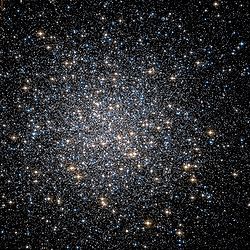Messier Index/M13
| M13 | |
|---|---|
 | |
| Observation data (J2000 epoch) | |
| Class | V |
| Constellation | Hercules |
| Right ascension | 16h 41m 41.44s[1] |
| Declination | +36° 27′ 36.9″[1] |
| Distance | 25.1 kly () |
| Apparent magnitude (V) | +5.8[1] |
| Apparent dimensions (V) | 23′ |
| Physical characteristics | |
| Mass | 1036 kg (6×105 [2] M) |
| Radius | 84 ly[3] |
| Estimated age | 1.4×1010 yr |
| Notable features | one of the best well-known clusters of the northern hemisphere |
| Other designations | NGC 6205[1] |
Messier 13 or M13 (also designated NGC 6205 and sometimes called the Great Globular Cluster in Hercules or the Hercules Globular Cluster) is a w:globular cluster in the w:constellation of Hercules.
Discovery and visibility
M13 was discovered by w:Edmond Halley in 1714, and catalogued by w:Charles Messier on June 1, 1764.
It is located at w:right ascension 16h 41.7m and w:declination +36° 28'. With an w:apparent magnitude of 5.8, it is barely visible with the w:naked eye on a very clear night. Its diameter is about 23 arc minutes and it is readily viewable in small telescopes. Nearby is w:NGC 6207, a 12th magnitude edge-on galaxy that lies 28 arc minutes directly north east. A small galaxy, IC 4617, lies halfway between NGC 6207 and M13, north-northeast of the large globular's center.
Characteristics
M13 is about 145 light-years in w:diameter, and it is composed of several hundred thousand w:stars, the brightest of which is the w:variable star V11 with an apparent magnitude of 11.95. M13 is 25,100 light-years away from w:Earth.
Arecibo message
The w:Arecibo message of 1974, designed to communicate the existence of human life to hypothetical extraterrestrials, was transmitted toward M13. The reason was that with a higher star density, the chances of a life harboring planet with intelligent life forms, were higher.
Literary references
- The w:science fiction novellas "w:Sucker Bait" by w:Isaac Asimov and "w:Question and Answer" by w:Poul Anderson take place on Troas, a world within M13.
- In the science fiction series w:Perry Rhodan, M13 is the location of Arkon, the home world of the race of Arkonides.
- In author Dan Simmon's w:Hyperion Cantos the Hercules cluster is where Earth was secretly moved to after it was supposedly destroyed.
- In w:The Sirens of Titan, w:Kurt Vonnegut writes "Every passing hour brings the Solar System forty-three thousand miles closer to Globular Cluster M13 in Hercules -- and still there are some misfits who insist that there is no such thing as progress."

External links
- Messier 13, SEDS Messier pages
- Messier 13, Galactic Globular Clusters Database page
- Messier 13, High-resolution LRGB image based on 2 hrs total exposure
- Messier 13, Image by Waid Observatory
- NightSkyInfo.com - M13, the Hercules Globular Cluster
- Photometric study of the V2 cepheid in M13
- Period, Amplitude and Light Curve of V38 in M13
- Great Globular Cluster in Hercules (Messier 13/NGC 6205)
- M13 images taken by Stargazer-Observatory
- M13
References
- ↑ a b c d "SIMBAD Astronomical Database". Results for NGC 6205. Retrieved 2006-11-15.
- ↑ Leonard, Peter J. T.; Richer, Harvey B.; Fahlman, Gregory G. "The mass and stellar content of the globular cluster M13".
{{cite web}}: CS1 maint: multiple names: authors list (link) - ↑ distance × sin( diameter_angle / 2 ) = 84 ly. radius
